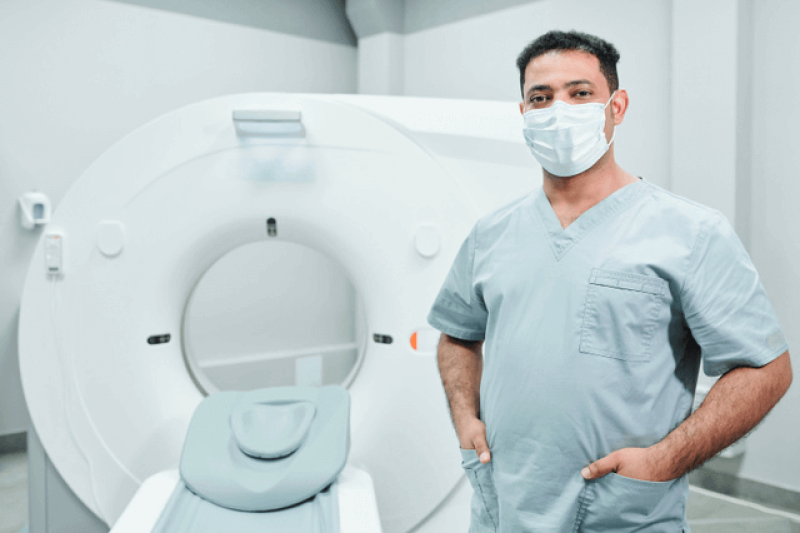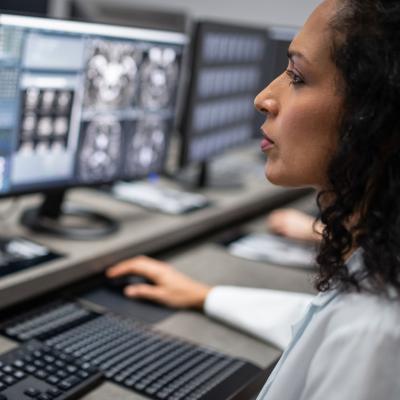- AdventHealth University

It attacks cancer cells. It reveals illness or healing. It offers a less invasive surgery option. Today, radiology is a powerful treatment, diagnostic, and surgical tool. Radiology procedures can save lives. People often have questions or concerns about radiology safety. The answers can offer peace of mind.
FAQs About Radiology Procedures
People scheduled for medical imaging, such as an X-ray or a vascular intervention, or other radiology procedures often have questions about what to expect, what they need to do, and how safe the procedures are. Medical imaging specialists are prepared to answer frequently asked questions like the following:
Do Procedures Expose Patients to Harmful Levels of Radiation?
Many patients worry that medical imaging procedures involving radiation can harm them or increase their risk for cancer.
Any exposure to ionizing radiation — electromagnetic waves or particles that help produce images of internal organs and tissue — can affect the body. However, medical imaging patients usually receive amounts of radiation that are quite low, and some imaging procedures don’t use radiation at all.
Repeated exposure to radiation over time can increase cancer risk, but that risk varies. Factors such as the frequency of exposure and a person’s age affect risk levels. Early exposures, for example, may put people at greater risk.
Does Sedation Cause Side Effects?
Sometimes, patients receive sedation during medical imaging. Sedation helps patients feel more relaxed and allows the procedure to be performed with reduced patient motion, increasing image quality.
For example, procedures such as angiography — which uses radiation imaging techniques and an injection of a contrast material to examine blood vessels — often use sedation to relax patients and prevent pain.
While sedation requires monitoring, it should not raise any serious safety concerns. Before a patient can receive sedation, a medical professional must screen them for any contraindications. Patients receiving sedation can experience temporary side effects, including:
- Tiredness
- Nausea or vomiting
- Mood shifts
- Dizziness
Sedation can sometimes trigger emotional upset or hyperactivity. Rarely, patients may experience allergic reactions or breathing issues. Healthcare teams know how to manage such issues, however, and they monitor patients closely.
What Are the Risks for Minimally Invasive Procedures?
Medical imaging is typically non-invasive, while allowing for a great deal of precision and visibility.
However, radiology also encompasses a procedure known as interventional radiology. The process uses medical imaging to allow doctors to perform diagnostic or medical procedures in a minimally invasive way, without the need for large incisions or general anesthesia. Patients who start out with these types of medical imaging may not need potentially invasive follow-up procedures.
Compared to open surgeries, minimally invasive procedures like interventional radiology have much lower rates of infection.
Interventional radiology procedures do carry some risks, including:
- Complications with anesthesia
- Infection
- Bleeding
Can MRIs Trigger Anxiety?
During traditional MRI scans, patients lie on a table that slides into a tube-like machine. They must lie still inside the machine anywhere from 12 to 60 minutes. For some patients, this can give rise to anxiety and discomfort, or even claustrophobia or panic attacks.
To help, radiologic technologists can encourage patients to breathe deeply and reassure them in a calm tone. They may also give patients towels to cover their eyes or headphones to listen to soothing music. Some diagnostic imaging centers have MRI machines with open designs, allowing patients to sit or stand with their faces uncovered. These alternatives can help relieve discomfort during MRIs.
Imaging centers may also provide sedation options for patients with anxiety.
Benefits of Radiology
Radiology offers substantial benefits to patients and healthcare professionals alike. Medical imaging has transformed the way patients are diagnosed and treated. Advancements in radiology technology, paired with radiology safety practices, have significantly lowered the number of invasive and risky procedures such as exploratory surgeries.
Specialties such as sonography offer advantages such as real-time imaging without the use of radiation and low cost. CT scans, on the other hand, quickly provide images that guide doctors navigating surgeries. Additionally, radiology procedures are typically non-invasive or minimally invasive, resulting in:
- Less physical trauma to the body
- Shorter hospital stays
- Fewer infections and other complications
- Faster recoveries
Common Misunderstandings About Radiology
Radiology’s specialized equipment produces images used to diagnose and treat disease. Radiology includes many types of medical imaging, but a common false idea is that all of them involve radiation. In spite of the name, some don’t. For example, sonography and MRI scans fall under the umbrella of radiology, but neither uses radiation to produce images.
Other misconceptions include:
- Myth: Radiation from medical imaging is dangerous, especially to pregnant women. Reality: The low radiation levels from these procedures don’t pose significant health risks, even to pregnant women. Physicians often utilize non-radiation imaging first before trying procedures that use radiation.
- Myth: X-rays are outdated. Reality: Traditional X-rays continue to play an important role in capturing diagnostic images and are vital for front-line and mobile use
- Myth: Radiation imaging causes headaches and nausea. Reality: Radiation doesn’t cause these symptoms. Patients who receive contrast material as part of their procedure may experience brief nausea.
Principles for Patient Safety in Radiology
Radiologists use safety practices to protect patients. The U.S. Food and Drug Administration outlines two important principles for patient safety in radiology: justification and dose optimization.
Justification
Despite the relative safety of medical imaging, radiologists must weigh the risks with the benefits. They must have enough justification to order medical imaging that uses radiation. The following situations often justify radiation imaging:
- It answers a medical question.
- It plays a valuable role in disease treatment.
- It guides a procedure.
Dose Optimization
To protect patients from harm, radiologists and imaging technologists should also use the lowest radiation doses possible that still allow for image qualities good enough for accurate diagnoses and interventions. Additionally, they must consider the medical history and clinical need of procedures using ionizing radiation to make sure the benefits outweigh any potential risks. They consider:
- The patient’s size
- The patient’s previous radiation exposure
- The part of the body to be scanned
Build a Career in Medical Imaging
Whether relieving patients’ fears about radiation procedures or capturing images that lead to life-saving diagnoses, medical imaging professionals play a vital role in healthcare. With the right skills, they can build successful careers in any number of specialty areas, each of which delivers invaluable help in treatment and diagnostics. AdventHealth University Online’s bachelor’s program in imaging sciences offers multiple tracks:
- Imaging Leadership
- Computed Tomography (CT)
- Magnetic Resonance Imaging (MRI)
- Vascular Interventional (VI)
- Sonography
- Interdisciplinary
Learn more about how AdventHealth University Online’s Bachelor of Science in Imaging Sciences empowers imaging technologists to build thriving careers.
Recommended Readings
How to Become an MRI Technologist
Types of Medical Imaging: Technologies and Career Options
Ultrasound Preparation: Purpose, Procedure and Tips for New Patients
Sources:
Agency for Healthcare Research and Quality, Radiation Safety
American Family Physician, “Interventional Radiology: Indications and Best Practices”
Canadian Cancer Society, Sedation
Carrus Health, Common Radiology Myths Debunked
Center for Diagnostic Imaging, “How to Get Through an MRI if You’re Claustrophobic”
HealthLinkBC, Radiation Exposure: Risks and Health Effects
International Atomic Energy Agency, X-rays — What Patients Need to Know
Mayo Clinic, Minimally Invasive Surgery
RadiologyInfo.org, Patient Safety
University Diagnostic Medical Imaging, Interventional Radiology
U.S. Food and Drug Administration, “Initiative to Reduce Unnecessary Radiation Exposure from Medical Imaging”


